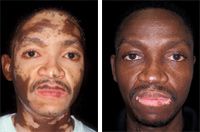- Acne
- Actinic Keratosis
- Aesthetics
- Alopecia
- Atopic Dermatitis
- Buy-and-Bill
- COVID-19
- Case-Based Roundtable
- Chronic Hand Eczema
- Drug Watch
- Eczema
- General Dermatology
- Hidradenitis Suppurativa
- Melasma
- NP and PA
- Pediatric Dermatology
- Pigmentary Disorders
- Practice Management
- Precision Medicine and Biologics
- Prurigo Nodularis
- Psoriasis
- Psoriatic Arthritis
- Rare Disease
- Rosacea
- Skin Cancer
- Vitiligo
- Wound Care
Article
The big picture: Phototherapy, topical combinations help improve vitiligo
Author(s):
Topical and phototherapy treatment options for vitiligo are increasing, and one expert says he combines modalities.

Key Points

Along with narrowband UVB, for example, there is the excimer laser, which has a wavelength of 308 nm, which is close to UVB's 311 nm to 313 nm.

Gold standard
The current gold standard for treatment, narrowband UVB phototherapy, offers a potent anti-inflammatory effect, and, if used appropriately, doesn't pose the side effect risks of sunburn or nausea and the increased cancer risk later in life, which were a concern with the previous phototherapy treatment of choice, UVA phototherapy with psoralen (PUVA).
And with results that can appear within two to three months, UVB has the advantage of creating faster improvement than PUVA treatment, which can take a year or longer.
With both narrowband UVB and excimer laser treatments, Dr. Crutchfield says that he starts very lightly, with a low dose, and gradually increases exposure for the best results.
"I treat patients of all skin tones as if they are Caucasian, and start them out at about 100 mJ/cm2 and gradually increase the exposure in increments of only about 10 to 15 joules," Dr. Crutchfield says.
"The same with excimer - I start with a low exposure and then work my way up," he says.
Repigmentation
Repigmentation with phototherapy can progress faster in some areas of the body than others.
"It's been my experience that the first repigmentation will show up on the face, followed by the neck, arms and trunk," Dr. Crutchfield says.
"The last, most difficult area to repigment is often the back of the hands and the top of the feet. For some reason, those areas are ultra-stubborn.
"Still, repigmentation on the face can show up in one to three months, and patients are usually thrilled about that," he says.
Topical treatments
Topical treatments, including topical steroids and nonsteroidal topical immunomodulators, still play a big role in vitiligo treatment, and Dr. Crutchfield says he sees the best results when they are combined with phototherapy.
"The standard treatment I use when I have a patient with vitiligo over the age of 6 is I'll put them on narrowband phototherapy, and I use three topicals - a topical steroid that is a Class IV, like Westcort (hydrocortisone valerate 0.2 percent, Westwood-Squibb), combined with 2 percent salicylic acid; and a topical nonsteroidal anti-inflammatory, such as Protopic (tacrolimus, Astellas) or Elidel (pimecrolimus, Novartis), because it's steroid-sparing," he says.
"In some younger patients, I'll use Protopic just three times a day, with or without phototherapy," Dr. Crutchfield says.
The salicylic acid helps give a boost to the steroid, he adds.
"It's a little-known, older pearl, but what salicylic acid does is it drives the steroid down deeper in the skin to provide a better effect," Dr. Crutchfield says.
The third topical Dr. Crutchfield uses is a topical vitamin D containing ointment or cream such as Dovonex (calcipotriene, Westwood-Squibb) or Vectical (calcitriol, Galderma).
Dr. Crutchfield says he has seen impressive results with topical vitamin D. He will sometimes incorporate products including Dovonex, a synthetic vitamin D3, in his treatment regimen.
Newsletter
Like what you’re reading? Subscribe to Dermatology Times for weekly updates on therapies, innovations, and real-world practice tips.











